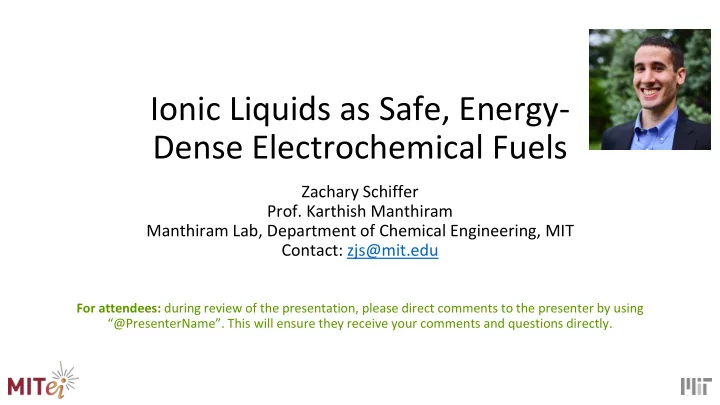

Ionic Liquids as Safe, Energy- Dense Electrochemical Fuels Zachary Schiffer Prof. Karthish Manthiram Manthiram Lab, Department of Chemical Engineering, MIT Contact: zjs@mit.edu For attendees: during review of the presentation, please direct comments to the presenter by using “@PresenterName”. This will ensure they receive your comments and questions directly.
A need for the ideal renewable energy carrier Volumetric Cheap and safe Energy Energy Easy and cheap High energy Efficient energy transport and Carrier Density to produce content extraction storage (kWh/L) 1 Li-ion Battery 0.2-0.7 Liquid H 2 2.3 Liquid 4.3 Ammonia Formic Acid 1.8 Ammonium 4.5 Formate 2
Paradigm: ammonium formate as energy carrier Safe, easily transported solid Formic Acid Generation Solid Conductive Electro- Salt Liquid chemistry Ammonium Transport Formate H 2 H 2 and Store e - Ammonia Production N 2 CO 2 Ammonium Formate is combination of formic acid and ammonia Forms ionic liquid at 116°C, meaning entire electrolyte is fuel
Electrochemical setup and product analysis Electrochemical cell with liquid ammonium formate Product analysis: Electrochemical analysis: Gas chromatography Impedance NMR Cyclic voltammograms Colormetric assays Chronoamperometry
Successful electrochemical H 2 extraction Cathode Anode + + 𝑓 − → 𝑂𝐼 3 + 1 − → 𝐷𝑃 2 + 𝐼𝐷𝑃𝑃𝐼 + 2𝑓 − 2𝐼𝐷𝑃 2 𝑂𝐼 4 2 𝐼 2 Future Work Currently only oxidizing formate Additives and cell engineering will allow for complete fuel oxidation
Acknowledgments & Questions Funding Sources: Advisor: Prof. Karthish Manthiram Manthiram Lab: @ManthiramLab
References 1. Jiao, F.; Xu, B. Adv. Mater. 2019 , 31 (31), 1 – 5. Muller, K.; Brooks, K.; Autrey, T. Energy Fuels 2017 , 31 , 12603 – 12611. 2. Ohyama, K.; Sugino, T.; Nitta, T.; Kimura, C.; Aoki, H. IEEJ Trans. EIS 2008 , 128 , 1600 – 1604. Aoki, H.; Nitta, T.; Kuwabata, S.; Kimura, C.; Sugino, T. ECS Trans. 2008 , 16 (2), 849 – 853 Ohyama, K.; Kimura, C.; Aoki, H.; Kuwabata, S.; Sugino, T. ECS Trans. 2007 , 11 (1), 1473 – 1477.
Backup Slides 8
Paradigm: ammonium formate as energy carrier Safe, easily transported solid Formic Acid Generation Solid Conductive Electro- Salt Liquid chemistry Ammonium Transport Formate H 2 H 2 and Store e - Ammonia Production N 2 CO 2 Extract electricity Extract hydrogen vs.
Experimental System ILs are conductive N 2 + Products N 2 In Out Pt Cathode Pt Anode Ammonium Formate (Liquid, ~115°C) 10 Manthiram Lab
Experimental System OCV predicted to be 0.04 V N 2 + Products N 2 In Out ILs are conductive Pt Cathode Pt Anode Ammonium Formate (Liquid, ~115°C) 11 Manthiram Lab
Ammonium Formate Decomposition Anode Evidence of formic acid/formate in post-cell trap Current (mA) FE toward CO 2 1 104% 3 77% 5 58% 6 86% Average FE = 81±8% (No evidence of N 2 ) Cathode Current (mA) FE toward H 2 1 138% 3 100% 5 96% Average FE = 110±10% Spectrophotometric evidence of Ammonia in post-cell trap 12 Manthiram Lab
Recommend
More recommend